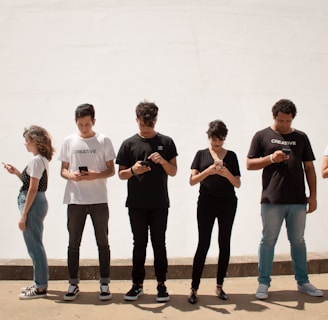Critical Analysis of Media and Society.
The relationship between media and society is intricate and multifaceted. Media plays a pivotal role in shaping societal perceptions, values, and behaviors. Acknowledging its influence and critically analyzing the content and messages conveyed by media is essential for an informed and empowered society.
COMMUNICATION
1/2/20243 min read


Critical Analysis of Media and Society.
The relationship between media and society is intricate and multifaceted. Media plays a pivotal role in shaping societal perceptions, values, and behaviors. It serves as a mirror reflecting the realities, ideologies, and cultural norms prevalent in society while also influencing and sometimes challenging them.
Certainly! When critically analyzing the relationship between media and society, a more detailed examination reveals several key aspects:
Media Ownership and Control:
Understanding who owns and controls media outlets is crucial. Concentration of media ownership among a few conglomerates can limit diverse viewpoints and prioritize specific agendas, affecting the plurality of information available to the public.
Gatekeeping and Censorship:
Media institutions act as gatekeepers, controlling the flow of information. This control can sometimes lead to censorship or biases, impacting the diversity of perspectives available to the public.
Power and Influence:
Media holds significant power in shaping public opinion and influencing societal attitudes towards various issues. The way events are covered, stories are framed, and information is presented can sway public perceptions, often aligning with certain agendas or ideologies.
Framing and Agenda Setting:
Media framing refers to how information is presented, emphasizing certain aspects while downplaying others. Agenda setting involves selecting which stories receive attention. Both framing and agenda setting influence public perception and understanding of various issues.
Biases and Stereotypes:
Media representations often contain biases and perpetuate stereotypes related to race, gender, sexuality, and socio-economic status. These representations can shape societal perceptions and reinforce existing prejudices or challenge them by promoting more inclusive narratives.
Example: Representation of Minorities in Hollywood
Media representations often perpetuate stereotypes. Hollywood has faced criticism for underrepresentation or misrepresentation of minorities, particularly in leading roles. This lack of diverse representation reinforces stereotypes and impacts societal perceptions of different ethnicities and cultures.
Political Influence and Propaganda:
Media can be used as a tool for political influence and propaganda, shaping public opinion to align with particular ideologies or political agendas. This influence may involve selective reporting, misinformation, or manipulation of facts.
Example: Use of Social Media in Political Campaigns
Social media platforms have become influential tools in political campaigns. Instances of misinformation, targeted ads, and algorithms reinforcing polarized content have raised concerns about the impact of social media on shaping political opinions and elections, notably seen in various global elections, including the US presidential campaigns.
Globalization and Cultural Impact:
With globalization, media transcends borders, influencing cultures worldwide. This phenomenon leads to both cultural homogenization and hybridization, impacting local cultures and identities.
Example: Impact of Western Media on Local Cultures
Globalization has led to the dominance of Western media, affecting local cultures. For instance, the prevalence of Hollywood movies and American TV shows worldwide has influenced local film industries, leading to a homogenization of cultural norms and values, potentially eroding indigenous cultural identities.
Consumerism and Commercialization:
Media is also a platform for advertising and consumerism. It often promotes certain lifestyles, products, and consumption patterns, contributing to materialism and defining societal values through commercial interests.
Social Media and Connectivity:
Social media platforms have transformed communication and information sharing. While providing connectivity and a platform for diverse voices, they also raise concerns about privacy, echo chambers, and the spread of misinformation.
Example: Misinformation Spread During the COVID-19 Pandemic
Social media platforms have facilitated the rapid spread of misinformation during the COVID-19 pandemic. False claims about cures, vaccine safety, and the origins of the virus proliferated on platforms like Facebook, Twitter, and WhatsApp, highlighting the challenge of curbing misinformation in the digital age.
Media Regulation and Ethics:
The balance between freedom of speech and responsible media practices is a critical aspect. Regulations and ethical guidelines play a role in ensuring fair, accurate, and unbiased reporting while safeguarding against harmful content.
Example: Regulation of Hate Speech and Online Content Moderation
Efforts to regulate online content have intensified due to concerns about hate speech and harmful content. Platforms like YouTube and Facebook have faced criticism for their algorithms amplifying extremist content. Governments and platforms have implemented policies to moderate content, raising debates about free speech, censorship, and the responsibility of tech companies.
Media Literacy and Education:
Promoting media literacy and education is essential. Teaching critical thinking skills helps individuals navigate media content, identify biases, evaluate sources, and differentiate between credible information and misinformation.
Example: Initiatives to Promote Media Literacy
Various initiatives and programs aim to enhance media literacy among the public. For instance, educational institutions and NGOs offer workshops and courses on critical thinking and media literacy to equip individuals with the skills to discern reliable information from misinformation in a media-saturated environment.
End Notes.
Overall, the relationship between media and society is intricate, dynamic, and constantly evolving. Acknowledging its influence and critically analyzing the content and messages conveyed by media is essential for an informed and empowered society.
© 2025 Copyright Amna Sadaf
